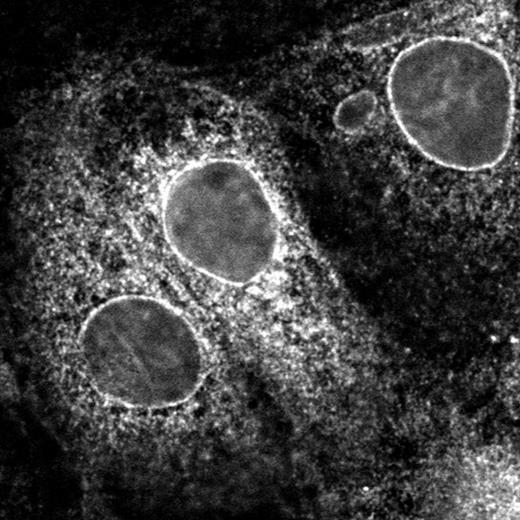Comment on Touret et al, page 1526
Abnormal processing, mislocalization, decreased stability, and diminished iron transport activity contribute to the functional deficiency and consequent iron deficiency seen with the G185R mutation in the metal transporter Nramp2.
Like other trace metal ions, iron is incapable of crossing cellular membranes by simple diffusion. The only identified transporter capable of mediating cellular iron uptake in higher eukaryotes is the integral membrane protein Nramp2 (also called DMT1 and DCT1). While Nramp2 transports certain other divalent metal ions as well, its role in iron uptake is most salient. Mutation of Nramp2 is responsible for the severe iron deficiency anemia recognized in 2 rodent populations—the mk mouse and the Belgrade rat. Curiously, the same glycine-to-arginine (G→R) amino acid substitution in Nramp2 is found in both mouse and rat models. Moreover, this G185R mutation has arisen independently in 2 different inbred mouse strains. The multiple independent occurrences of this mutation suggest the possibility of a gain-of-function and selective advantage for the mutant Nramp2 protein. Indeed, recent evidence demonstrates that Nramp2 G185R, unlike wild-type Nramp2, has the ability to transport calcium.1 No other Nramp2 mutations have been reported, and it appears that a complete knockout of Nramp2 in mice results in a newborn lethal phenotype (communication cited in Xu et al1 ). These observations suggest that G185R Nramp2, although defective, may have residual iron transport properties. Thus, there is considerable interest in the cell biology and functional properties of G185R Nramp2 mutant protein.FIG1
Subcellular distribution of Nramp2G185R. See the complete figure in the article beginning on page 1526.
Subcellular distribution of Nramp2G185R. See the complete figure in the article beginning on page 1526.
Previous investigations have identified 2 different mechanisms by which the G185R mutation may be deficient as an iron transporter. Su et al found that Nramp2 G185R was functionally inactive as an iron transporter when heterologously expressed in HEK293 cells.2 Cannone-Hergeaux et al analyzed expression of Nramp2 in the duodenal epithelium of mk mice and determined that the mutant protein did not target to the cell surface.3 In this issue of Blood, Touret and colleagues carefully examined these and other possible mechanisms by which the G185R is defective. They stably expressed in HEK293 cells one of the Nramp2 isoforms and the corresponding G185R mutant protein. The investigators found that although wild-type Nramp2 exists primarily as a “complex-glycosylated” protein in the plasmalemma, the G185R Nramp2 protein exists primarily as a “core-glycosylated” precursor in the endoplasmic reticulum. This mutant Nramp2 precursor is subject to rapid degradation by a proteosome-dependent mechanism. Although a small fraction of the G185 mutant Nramp2 is fully glycosylated and traffics to the plasmalemma, this fraction has a shortened half-life. The activity of this residual fraction, after normalizing for the level of expression at the cell surface, was found to be only 60% of wild-type Nramp2.
There are only a few limitations to this extensive body of work. Only 1 of the 4 different Nramp2 isoforms was studied, and it is possible that another isoform of the mutant protein may be processed to a different degree. Furthermore, marked overexpression of the mutant protein in these studies may have overwhelmed cellular compensatory mechanisms and exaggerated abnormalities in processing and/or trafficking. Finally, it is possible that cellular processing of the mutant protein may be different in the cell types in which Nramp2 expression is functionally most important (eg, polarized duodenal mucosal cells and erythroid precursor cells). It is unlikely, however, that any of these issues challenge the most important observations: (1) markedly decreased expression of G185R Nramp2 on the plasmalemma; and (2) modest decrease in transport activity.
The authors propose a model in which abnormal folding of the mutant protein promotes the rapid proteosomal degredation and downstream events. If this model is correct, these deficits might be partially overcome by the use of chemical chaperones. In summary, the Nramp2 G185R protein was found to demonstrate multiple biosynthetic and functional deficits: abnormal processing, increased degradation, mislocalization, and decreased transport activity. Through their careful analysis, Touret and colleagues were able to corroborate 2 studies with potentially disparate findings and add important new observations to explain the functional deficits of G185R Nramp2.


This feature is available to Subscribers Only
Sign In or Create an Account Close Modal